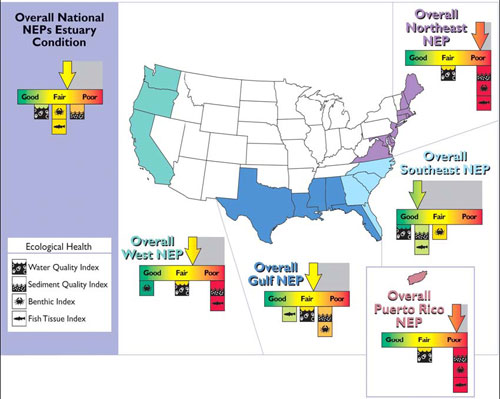|
EPA 842-F-06-001

What is the National Estuary Program Condition Report?
EPA issued the National Estuary Program Coastal Condition Report (NEPCCR) in June, 2007. It is the third in a series of coastal
environmental assessments. The first two reports covered all U.S. coastal waters. This Report includes assessments of the twenty-eight
National Estuary Programs(NEPs) in the U.S. and Puerto Rico. Estuaries are bodies of water where fresh water from rivers meets the
saltwaters of the ocean. This interaction provides a unique, highly productive environment that supports a great diversity of wildlife
and fisheries and contributes tremendous value to the nation´s economy. The NEPCCR presents two major types of data for each NEP
estuary:(1) estuarine monitoring data collected as part of EPA´s National Coastal Assessment surveys, and (2) estuarine monitoring
data collected by the individual NEPs or by the NEPs in partnership with interested stakeholders, including state environmental agencies,
universities, or volunteer monitoring groups.

What is the National Estuary Program?
In 2007, the National Estuary Program, established as part of the 1987 amendments to the Clean Water Act (CWA), celebrates its 20th
anniversary of protecting and restoring estuaries of national significance. The program promotes comprehensive planning efforts and actions
to help protect 28 designated estuaries that are deemed to be threatened by pollution, development, or overuse. Between 2000 and 2006, the
NEPs restored and protected one million acres of habitat. The CWA also requires that EPA report periodically on the condition of the
nation´s estuarine waters.
What is the Overall Condition of the Nation's NEPs?
Overall condition of the nation´s NEPs is fair. This rating is based on four indicators of estuarine condition-water quality index
(e.g., dissolved inorganic nitrogen, dissolved inorganic phosphorus, chlorophyll a, water clarity, and dissolved oxygen), sediment
quality index (e.g., sediment toxicity, sediment contaminants, and sediment total organic carbon), benthic index, and a fish tissue
contaminants index. For each of these four key indicators, we assigned a score of good, fair, or poor to each NEP. We then averaged these
ratings to create overall regional and national scores illustrated in the map on the first page, using "traffic light" color scoring.
Population pressures in the NEPs were greater than those in non-NEP estuaries from 1990-2000, yet, the NEP estuaries showed the same or
better estuarine condition than our coastal waters overall.
 |
| Patty Scott, EPA |
Our Treasured Estuaries
Estuaries serve as feeding, spawning and nursery grounds for many species of finfish, shellfish and birds that spend most of
their adult lives in the ocean. Estuaries provide habitat for more than 75 percent of America´s commercial fish catch and 80 to 90 percent of recreational
fish catch The continued viability of these fisheries depends on continued good health of their habitat.
Summary of Other Findings
The NEP indicators that show the poorest conditions throughout the United States are sediment quality, fish tissue contaminants
(rated fair), and benthic condition (rated fair). The indicator that generally shows the best condition is water quality (rated fair).
Nationally, 37% of NEP estuaries are in poor condition. Regionally, Puerto Rico´s NEP estuary (San Juan Bay) is in poor condition,
and about 46% of the Northeast Coast, 46% of the Gulf Coast, 36% of the West Coast, and 23% of the Southeast Coast NEP estuaries are in
poor condition.
For More Information:
The National Estuary Program Coastal Condition Report reflects a collaborative effort among the U.S. EPA, and the individual National
Estuary Programs and their partners.
Consistent with the Oceans Commission report (www.oceancommission.gov), this report sends
a clear message about the serious challenges facing our nation´s ocean and coastal resources.
For more information, contact:
Barry Burgan in EPA´s Office of Wetlands, Oceans and Watersheds at (202) 566-1242 or Virginia Engle in EPA´s Office of Research
and Development at (850) 934-9354.
For a copy of the report, please call 1-800-490-9198 and request EPA publication # EPA-842-B-06-001 or visit EPA´s web site at:
www.epa.gov/owow/oceans/nepccr/.
EPA-842-F-06-001
|
You will need Adobe Acrobat Reader to view the Adobe PDF files on this page.
See EPA's PDF page for more
information about getting and using the free Acrobat Reader. |
|

